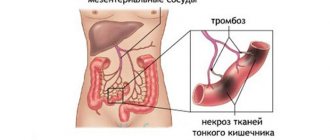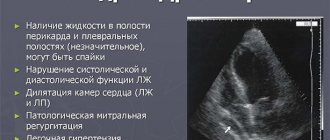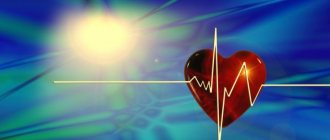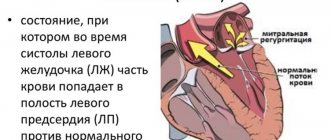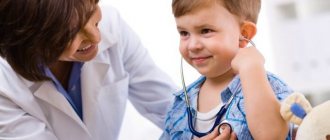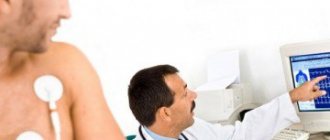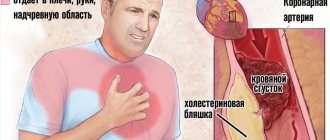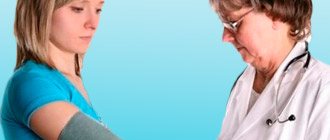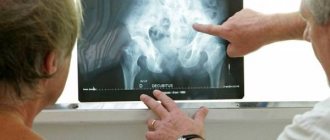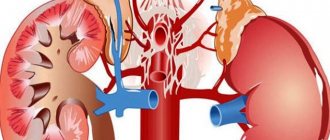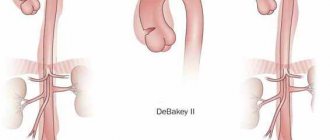5 / 5 ( 4 voices)
It is mistakenly believed that colitis is some kind of colic. In fact, this is an inflammation of the large intestine, which is often complicated by:
- gastritis;
- inflammatory processes in the small intestine.
Treatment of colitis in adults is carried out with medicinal methods aimed at:
- to relieve inflammation;
- normalization of internal microflora;
- normalization of digestion.
What is colitis
The International Classification of Diseases places colitis according to ICD-10 under the code K50-K52. The disease is characterized by the presence of an inflammatory process in the colon and occurs in:
- acute form;
- chronic form.
The causes of inflammation are:
- infections;
- toxins;
- ischemic organ damage.
Do not confuse colitis and colic; the latter are only a symptom of the disease and are expressed in attacks of dull pain in the lower abdomen. The word “colitis” does not come from “prick”; it is translated from Latin as “inflammation of the intestines.”
Symptoms of intestinal colitis in women
During clinical observations, it was concluded that women develop colitis more often than children or men.
Very often, the cause of colitis in women is the use of cleansing enemas to remove toxins and reduce weight. In addition, most weight loss products, which are so popular among women, negatively affect the functioning of the intestines and their condition and can even cause colitis.
Women may experience the following symptoms of colitis:
- violation of the general condition (weakness, loss of appetite, decreased performance, etc.);
- abdominal pain;
- heaviness in the stomach;
- bloating;
- diarrhea;
- tenesmus;
- temperature rise and others.
The severity of the above symptoms depends on the cause, course and location of colitis.
Why does colitis occur?
To answer this question, it is worth looking at some questions from anatomy. The intestine is divided into two sections:
- thick;
- thin.
Each part of the organ has its own processes. The small intestine processes leftover food after it has left the stomach, and this is where:
- release of useful substances;
- absorption of useful substances into the blood.
The large intestine is separated from the small intestine by a thin mucous membrane that prevents waste from entering the small intestine. The colon contains:
- bacteria that finally process leftover food;
- pathogenic microflora.
Pathogenic microflora grows due to:
- poor nutrition;
- poisoning
And the number of pathogenic microorganisms increases sharply, which leads to inflammation of the colon mucosa. This is how colitis develops. If toxins and pathogenic bacteria still penetrate the small intestine, the disease worsens and is complicated by enterocolitis.
Inflammation of the large intestine can result from:
- pathogenic microflora;
- toxins;
- side effect of taking certain medications.
In some cases, colitis may be a consequence of other pathological changes in the body.
Photo: Stages
Diagnostics
To determine the causative agent of the disease, it is necessary to conduct a multifaceted examination. In addition to standard laboratory diagnostics (blood, urine, stool tests (coprogram)), examination, it is advisable to resort to more clarifying instrumental methods.
Instrumental diagnostics
PCR
(polymerase chain reaction) is a molecular genetic diagnosis. PCR can predict future health problems and tell what a person will get sick with, taking into account the hereditary factor. PCR is done for colitis to identify the microbial pathogen for further therapeutic actions against it.
Contrast irrigoscopy
is performed using a substance visible on x-rays (barium suspension), which the patient must swallow. Sometimes the substance is administered by enema. Irrigoscopy takes snapshots, showing pathological changes from the inside.
Colonoscopy
carried out using a long endoscope (probe type). An endoscope is inserted through the anus, and sedatives are administered intravenously. At the patient's request, general anesthesia is performed. Colonoscopy is a mandatory procedure if pathologies of the large intestine have been identified; it makes it possible to examine the entire large intestine, but does not have the opportunity to examine the small intestine, so an MRI is prescribed.
MRI
(magnetic resonance imaging) is a non-radiation method for examining the gastrointestinal tract. This is the most informative diagnostic method along with CT (computed tomography). MRI is more suitable for examining soft tissue. Good visualization of malignant formations.
CT
has a radiation dose, but takes very detailed images of organs. Computed tomography is better at distinguishing solid structures of the body.
Sigmoidoscopy
carried out using a rectoscope (endoscope), which is inserted through the anus. During sigmoidoscopy, the rectum and sigmoid colon are examined. The difference between sigmoidoscopy and colonoscopy is that they examine different parts.
Intravenous angiography
is done if there is a suspicion that the disease began due to problems with blood vessels (for example, ischemic colitis).
Anoscopy
– the rectum is examined. Anoscopy allows you to diagnose colitis in the early stages.
The examination makes it possible to differentiate ordinary pathology from ulcerative one. The next stage after hardware research will be treatment.
What influences the development of the disease
There are many reasons why colitis can develop. Here are the main ones:
- intestinal infections (fungi, viruses, parasites, etc.);
- side effect of antibacterial therapy;
- impaired blood supply;
- unhealthy diet (heavy fatty foods, spicy seasonings, monotonous food, alcohol);
- radioactive exposure;
- dysbacteriosis;
- allergic reaction;
- heavy metal poisoning;
- genetic predisposition;
- infectious processes in nearby organs,
- stress.
In some cases, the cause of the disease cannot be discovered. Colitis also occurs during pregnancy. In this situation, even a common allergy can be its cause. In any case, a pregnant woman must visit a doctor. In case of inflammatory or infectious processes in the body, there is a high risk of harming the unborn child.
Stitching pain - as a symptom of pathology of internal organs
With inflammation, deformation or degenerative changes in organs, the patient may experience discomfort of varying intensity and duration.
Most often, the occurrence of painful sensations under the ribs on the right is influenced by:
- Hepatitis, cirrhosis.
- Pancreatitis.
- Cholecystitis.
- Inflammation or neoplasm on the pancreas.
- Appendicitis.
- Polycystic disease.
- Pyelonephritis.
- Pneumonia or pleurisy.
- Inflammation of the appendages.
- Thrombosis of the inferior vena cava.
Classification of colitis
The classification is based primarily on the etiology of the disease. Due to its occurrence, colitis is divided into:
- infectious;
- nutritional (related to nutrition);
- toxic;
- drug;
- mechanical (for constipation or damage to the mucous membrane);
- allergic.
In the case when colitis arose under the influence of several factors at once, we are talking about a combined form of the disease. The disease is also divided into acute and chronic forms.
Is it possible to figure it out on your own?
Colicky pain occurs with inflammatory infiltration of tissues, purulent-necrotic lesions, and accompanies purely physical damage to organs. Its origin can be accurately determined only through diagnostic procedures and laboratory tests. You can suspect where the discomfort is coming from on your own. To do this, you should focus on the accompanying symptoms.
Pathologies in the chest
Colic is always accompanied by damage to the lung tissue. Provocateurs of pain are inflammatory lesions in pneumonia, purulent-necrotic lesions in tuberculosis. Pain also accompanies the formation of pulmonary tumors. It acquires a stabbing character in the later stages of oncology. The pain may be due to inflammation of the diaphragm. It develops against the background of inflammatory lesions of the lungs or congestive processes.
Stitching pain due to the lung is constantly present, intensifies with changes in body position. The intensity increases when coughing, sneezing, or taking a deep breath. It decreases if you breathe shallowly and lie on the other side. Discomfort with chest lesions is accompanied by an increase in body temperature and symptoms of general intoxication (weakness, drowsiness, lack of appetite).
Occasionally, right-sided pain under the ribs indicates myocardial infarction. In this case, it radiates to the corresponding arm, collarbone, scapula and is not relieved by Nitroglycerin.
Diseases of the digestive glands
Stitching pains often accompany inflammation of the pancreas - acute and chronic pancreatitis. This organ is located deep in the abdominal cavity, in its upper part. The gland is extended to the left side. Its expanded part (head) is located under the lower right costal arches. Inflammation in this area manifests itself with a sharp stabbing discomfort in the right side. The sensations intensify after eating and gradually spread to other areas.
Pancreatitis is characterized by girdle pain. The discomfort that occurs on the right quickly spreads to the epigastric region and left side. Additional symptoms are nausea, a feeling of heaviness in the abdomen, stool disorders, pale skin.
The second gland from which pain can come is the liver. The organ itself has no innervation. Painful sensations in the right hypochondrium occur with lesions of the gallbladder. This is a hollow contractile organ in which bile accumulates. With circulatory disorders, congestive processes, and poor nutrition, stones form in the bladder (cholelithiasis). They can enter the bile duct during a reflex release of bile. Stones can completely block the lumen of the duct, damaging its walls and the tissues of the bladder itself.
When bacteria enter the bile, cholecystitis develops. The pathology is accompanied by stabbing pains, which sometimes develop into hepatic colic (very severe pain). Among the accompanying symptoms are nausea, vomiting, fever, icteric syndrome (yellowing of the sclera, mucous membranes, skin throughout the body, the appearance of a hemorrhagic rash).
Pain in the side comes from the liver with serious inflammatory and degenerative lesions of the organ (hepatitis, cirrhosis, steatosis). Severe discomfort occurs in the later stages of the pathology, when the liver capsule and surrounding organs are involved in the process.
Pain due to intestines
Acute colic-like pain on the right can accompany intestinal diseases. For example, duodenitis (inflammation of the duodenum), in which ulcers form on the mucous membrane. The pain often occurs at night and becomes less intense after eating. Accompanied by nausea, bloating, heaviness in the abdomen, and weakness.
Possible complications
One of the most dangerous consequences of colitis is peritonitis, which develops in case of perforation of the intestinal walls. The process occurs so quickly that urgent medical attention is required, otherwise death is possible.
Other consequences of colitis include:
- Bleeding in the intestines.
- The appearance of scars and adhesions.
- Dehydration.
- Development of ulcers.
- Sepsis.
Most complications after colitis are life-threatening for the patient and require immediate treatment.
Symptoms and signs of colitis
Symptoms and signs depend on the form of the disease. So, in the acute stage, the patient may complain of:
- pain and discomfort;
- stool disorder;
- blood and mucus in the stool;
- false urge to have a bowel movement;
- heaviness and bloating in the abdomen.
Chronic colitis often occurs when the disease is not treated or the doctor is consulted too late. In this case, most of the symptoms are the same as in the acute form, but are milder:
- flatulence;
- rumbling;
- bowel disorder: diarrhea, diarrhea;
- pain (mild);
- weakness;
- nausea;
- skin rash.
During exacerbations, which occur up to several times a year, symptoms intensify. Ulcerative colitis is much more severe than chronic colitis. The presence of ulcers, or even damage to the intestinal walls, greatly complicates the course of the disease.
Characteristic symptoms:
- stool incontinence;
- false urge to defecate;
- blood, mucus, pus in the stool;
- constipation;
- weakened state as in ARVI.
In severe cases it is possible:
- increased body temperature;
- increased heart rate;
- decreased appetite;
- lethargy;
- weakness.
Causes of the symptom
Stitching pain may be due to problems with bones or internal organs located nearby
Stitching pain in the right shoulder blade in men and women is not a specific symptom and can be characteristic of various diseases. The nature of the pain is diffuse or local, acute or chronic. Usually its occurrence indicates pathologies of the spinal column and adjacent bones:
- History of scapula injury. Increased physical activity or sudden movement can cause a bone dislocation. Strong traction promotes unnatural rotation of the scapula and slipping to the outside. The result is a tear in the muscles attached to the medial border of the bone and the spinal column. Characteristic symptoms are severe sharp pain at the site of injury, impaired mobility, and swelling.
- Disturbances in the development of the scapular region. These can be various congenital anomalies, for example, aplasia of the scapula, pterygoid scapula, high bone position, etc. The congenital form of the pterygoid scapula is differentiated from acquired pathology, which is caused by injury to this area, myopathy, muscle paralysis.
- Tumor-like lesion. Benign (chondroma, osteoma, osteochondroma) and malignant (reticulosarcoma, chondrosarcoma) processes occur in the scapula. If the nerve processes are involved in the lesion, persistent shooting pain occurs, which is difficult to relieve with conventional analgesics.
- Osteomyelitis of the scapula. The development of pathology is caused by damage to this section and its infection. Symptoms of intoxication occur and mobility is impaired. If the purulent process has spread to the front of the scapula, deep muscle swelling and severe pain appear.
Inflammation in the gallbladder and pancreas can cause tingling under the shoulder blade
Tingling from the back of the right hypochondrium with irradiation to the scapula is caused by the following pathologies of internal organs:
- Exacerbation of pancreatitis. A girdling pain occurs, which compresses and hampers movement, spreading under both shoulder blades. Discomfort manifests itself on a constant basis, does not depend on changes in the position of the body, and does not increase with inhalation and deep breathing, coughing, or tension.
- Hepatic colic. Intense pain symptoms of a stabbing nature occur, which can radiate not only to the shoulder blade, but also to the shoulder and neck. The attack continues for a long time (4-5 hours, and sometimes longer), and is accompanied by nausea and vomiting.
- Cholelithiasis. Disruption of the gallbladder occurs with acute pain symptoms, which radiate to the bottom of the right shoulder blade, neck, jawbone, and shoulder. Rarely, discomfort radiates to the heart - “cholecystocoronary syndrome”.
- Subphrenic abscess. Purulent contents in this area occur due to bacterial infection. Stitching discomfort intensifies with deep inspiration, complemented by a slight increase in general temperature.
With heavy loads during training, microcracks may appear in the muscles.
The reasons why the stabbing under the right shoulder blade may be pathologies of the musculoskeletal system:
- Osteochondrosis of the cervical or thoracic spine. The degenerative-dystrophic process is accompanied by blockade or instability of the vertebrae, spinal canal stenosis, disc herniation, arthrosis of the facet joints - conditions that occur with sharp, acute, piercing pain in the affected area with irradiation to the shoulder blades. With cervical osteochondrosis, you may feel dizzy and experience pain in this area (usually in the back of the head).
- Humeroscapular periarthritis. The pathology is characterized by various disorders of the tendons, ligaments and muscles in the area of the scapulohumeral region. The cause is sudden movement, muscle tension as a result of prolonged sitting, and systematic overload of the shoulder area.
- Myofascial pain. Trigger points (areas of hypersensitivity) are formed in the muscle-tendon system, pressing on which causes a sharp, shooting pain. Shots are possible in the head, neck, thighs, buttocks and even feet. Causes: microscopic muscle damage, prolonged physical activity, and poor posture.
With intercostal neuralgia, it is difficult to breathe deeply, the pain most often occurs around the body
If there is a stabbing sensation under the shoulder blade on the right side of the back, you need to be examined by a neurologist, as the cause may be a neurological condition:
- Intercostal neuralgia. The pathology often accompanies diseases of the spine that occur with displacement of the intervertebral discs to the right side. This compresses the nerve roots, which causes acute shooting pain. Other sources of discomfort include the formation of a hernia, osteophytes, and tumors.
- Vegetative-vascular dystonia. Psychomatic disorder occurs as a result of an inadequate response of the autonomic nervous system to the action of a stress factor. As a result, the functioning of internal organs and systems is disrupted, which is accompanied by unmotivated pain in the spinal region, dizziness, nausea, and anxiety syndrome.
If there is a stitch in one shoulder blade, acute pain occurs, it is difficult to take deep breaths and it hurts to breathe, you need to visit a therapist who, if necessary, will refer you to another specialized doctor: a traumatologist, vertebrologist, neurologist, etc.
Methods for diagnosing colitis
When diagnosing colitis, it is first of all important to exclude the possibility of other diseases.
It is mandatory to undergo the following procedures and tests:
- Colonoscopy.
- Stool analysis for parasites.
- General blood analysis.
- Irrigoscopy.
- Digital examination of the anus.
To clarify the diagnosis, an examination may be performed:
- using ultrasound;
- take samples for inflammatory processes in the liver and pancreas;
- A biopsy is necessary to rule out the possibility of a cancerous tumor.
Symptoms of colitis in children
The course of colitis in children is more violent and severe than in adult patients.
Colitis of infectious etiology in children is often accompanied by severe intoxication and dehydration.
can be identified in a child :
- fever;
- exhaustion;
- severe general weakness;
- pain that is localized around the navel;
- tenesmus;
- diarrhea, with frequent stools up to 15 times a day;
- watery, foamy, often greenish stools that contain a lot of mucus and streaks of blood;
- decreased skin turgor;
- dry skin and mucous membranes;
- decreasing the daily amount of urine and others.
Chronic colitis in a child has less pronounced manifestations than acute intestinal damage.
Most often, a child has symptoms such as:
- pain in the abdomen of an aching nature, which is associated with eating or defecation, and is noted in the navel, right or left half of the abdomen, depending on the segment of damage to the large intestine;
- constipation or diarrhea;
- feces contain a lot of mucus, streaks of blood and undigested food particles;
- change in the consistency of feces (sheep feces, ribbon-like feces, watery feces, etc.);
- rumbling in the stomach;
- bloating.
Due to constipation or diarrhea, a child may develop anal tears and prolapse of the rectal mucosa.
Parents should not ignore the above symptoms in a child, since a long-term inflammatory process in the intestines often leads to delayed physical development, anemia, metabolic disorders and vitamin deficiency in the body.
Treatment of the disease
Help for colitis depends on what exactly is causing the disease.
What means are used:
- If the culprits of inflammation are microorganisms, the doctor prescribes a course of antibiotics.
- To get rid of parasites, you will need to take anthelmintic drugs. Only a doctor selects medications and dosage; it is extremely undesirable to prescribe treatment on your own.
- To restore digestion impaired by antibiotics, you will need a course of probiotics and prebiotics.
- Sorbents are used in cases of poisoning to quickly remove toxins from the body. These same drugs are used to relieve unpleasant symptoms such as nausea.
- If the disease occurs with severe pain and spasms, antispasmodics will be required.
- In addition, it is necessary to strengthen the body and immunity, for which vitamin and mineral preparations may be additionally prescribed.
As for traditional treatment methods, doctors are skeptical about such remedies. Attempts to treat colitis with herbal decoctions and other means can only worsen the course of the disease.
Treatment of colitis
In case of acute course or exacerbation of the chronic form, all therapeutic effects must be carried out in a hospital setting. If a specific microflora is detected, the patient is sent to the infectious diseases department.
When chronic intestinal colitis is diagnosed, it is better to carry out sanatorium-resort treatment. It is worth choosing those boarding houses that specialize in the treatment of the digestive system. Physical influence and alternative medicine are not excluded. But such methods, including sanatorium-resort methods, should be carried out only on the advice of the attending physician.
Traditional methods
Gastroenterologists for intestinal colitis recommend courses of physiotherapeutic procedures, such as mud packs, magnetic therapy and even acupuncture. Surgical interventions are necessary only in severe cases and for certain indications. This treatment is used in cases of chronic disease.
From folk treatment, the following remedies are indicated:
:
- decoctions of caraway, sage and St. John's wort, which effectively eliminate inflammation;
- motherwort, nettle and mint help avoid increased gas formation;
- a decoction of calendula and chamomile relieves spasms in the intestines;
- in case of ulcerative lesions, sea buckthorn oil is indicated, which is used in the form of microenemas at night;
- chamomile and centaury provide good antistatic treatment and healing of affected areas.
Usually these funds are auxiliary. To eliminate intestinal colitis, medications are required.
Medications
Traditional therapy provides rapid relief. In combination with folk remedies, it will be more effective. But it is necessary to exclude all contraindications and combinations with medications.
Commonly used medications are:
:
- Motilak, a stimulant of intestinal motility;
- Magnesium sulfate and Bisacodyl, as a saline laxative;
- Papaverine, Duspatalin and No-shpa as an antispasmodic agent;
- Sinode is a drug with a laxative effect;
- Creon to improve digestion;
- Neosmectin and activated carbon to eliminate toxic substances;
- B vitamins and nicotinic acid, which ensure the regeneration of damaged tissues;
- Tetracycline, Furazolidone, Enterofuril and Loperamide to eliminate inflammation and antimicrobial effect;
- Allochol and Holosas have a choleretic effect in gallbladder pathology.
Physiotherapy is indicated for additional therapeutic effects. Intestinal colitis requires improvement of motor-evacuation and secretory functions of the gastrointestinal tract.
For this purpose, the following methods are recommended
:
- electrophoresis with papaverine and drotaverine;
- magnetic therapy;
- applications with paraffin and mud on the abdominal area;
- UHF;
- local ultraviolet irradiation.
In severe cases, surgery is indicated. Surgical intervention is usually performed for ulcerative disease, if intestinal colitis has developed according to the type of ischemic lesions. In this case, it is necessary to influence the formation of a blood clot in the abdominal artery.
Diet for colitis
Photo: diet
Successful treatment is impossible without diet and proper nutrition for colitis.
The dietary menu includes:
- cereals (rice and pearl barley);
- dried bread;
- some fermented milk products;
- butter;
- eggs (maximum 1 egg per day);
- fresh fruits (apples, pears, peaches);
- berries;
- tea;
- jelly;
- sweets in small quantities.
But you will have to exclude from the diet:
- fresh bread and pastries;
- all legumes;
- nuts;
- fatty meat and fish;
- milk;
- fast food and semi-finished products;
- store-bought juices;
- dried fruits;
- watermelons and melons.
You should also not eat:
- roast;
- salty;
- spicy;
- smoked;
- canned food;
- any types of sausages.
If you have colitis, you need to drink plenty of fluids to prevent dehydration. The following types of diets may be considered:
- table number 1;
- table number 2;
- table number 4.
Treatment
Treatment of the disease depends on the type of colitis and its form. The reasons that provoked its occurrence and the characteristics of the course of the disease are taken into account. If the causative agent of the disease is an infection, antibiotics are prescribed (Metronidazole), for ischemic types of the disease - treatment is with vascular drugs that improve intestinal blood flow, to relieve pain - antispasmodics (No-shpa, Duspatalin, Meteospasmil and others ). For helminthic colitis, antiparasitic drugs are prescribed.
For proctitis and sigmoiditis - medications in the form of suppositories. If the disease is provoked by the use of medications to eliminate another type of disease, then their use is canceled. The chronic form involves the use of complex techniques, as well as sessions with a psychotherapist. In case of exacerbation of a chronic type of disease or acute colitis, treatment is carried out in the proctology department, if the infectious nature is determined - in infectious diseases hospitals.
Treatment of colitis in adults and children is carried out comprehensively. For all types of disease, diet, intestinal adsorbents (activated carbon), drugs to regulate stool (laxative “Guttalax” or antidiarrheal “Loperamide” “Hilak Forte”, restoring motility “Trimedat”), stimulating regeneration “Methyluracil”, for recovery are always indicated. microflora - prebiotics and probiotics (Linex), detoxification treatment, vitamins, mineral waters.
How to treat chronic colitis
As mentioned, different forms have some differences not only in symptoms, but also in treatment methods.
Chronic colitis is a disease whose treatment is based not on medications, but on diet and proper nutrition. Antibacterial drugs are prescribed only during exacerbations.
Sample menu recommended for chronic colitis:
| Breakfast 7.30 | Rice porridge on water (with the addition of one third of milk) with butter - 5 g, a glass of tea |
| Lunch 12.00-13.00 | Noodle soup with meat broth – 1 plate, steamed meat cutlets (150 g) with carrot puree (150 g), apple jelly – 1 glass |
| Dinner 17.00-18.00 | Boiled fish (85 g), mashed potatoes (150 g), cheese (25 g), savory bun, glass of tea |
| For the night 20.00 | A glass of kefir with bread or tea (glass) with dry cookies |
Throughout the day you can eat white bread (400 g) and sugar (50 g).
In addition to diet, it is possible to prescribe antibiotics (in order to overcome harmful bacteria), means to restore intestinal microflora, and it is possible to prescribe antispasmodics for spasmodic symptoms. If the disease was the result of a nervous breakdown (nervous) or overstrain, then treatment by a psychotherapist is also prescribed.
Treatment of ulcerative colitis
Ulcerative colitis is more difficult to treat. Treatment medications have many side effects, so they are used strictly as prescribed by a doctor (according to the treatment regimen). They are produced in the form of rectal suppositories, enemas, tablets (Pentasa, Mezavant, Mesacol). Sometimes they resort to biological therapy drugs - Remicade (Infliximab). In more severe cases, corticosteroid medications (Prednisolone, Hydrocortisone) are used.
A diet is also prescribed. All dishes are boiled, steamed or baked. Food should be pureed or crushed; meals should preferably be fractional, with a minimum fiber content.
You should not eat when you are sick:
- salted, smoked, spicy or pickled dishes;
- vegetables and fruits without processing;
- baked goods;
- wheat and pearl barley cereals, legumes;
- chocolate, ice cream;
- carbonated drinks, strong tea or coffee (if constipated).
Treatment of enterocolitis
Treatment of enterocolitis involves the use of a water-tea diet. If necessary, gastric lavage is prescribed. Severe diarrhea and vomiting require control over the volume of fluid entering the body. Painful symptoms are relieved with the help of antispasmodics.
Traditional methods of treatment
The method of treating colitis with folk remedies at home depends on the type of disease. Most often, colitis and enterocolitis are treated with herbs, which involves taking decoctions of chamomile, centaury and sage.
How are herbs useful for colitis, why are they better than drugs?
This decoction can be taken for a long time if you are worried about intestinal colitis, since drug treatment is quite long. Inflammation can be relieved by mint infusion, which is used 3-4 times a day before meals. Pomegranate decoction from the peels of the fruit helps well against allergic colitis and enterocolitis.
Prevention
Recommendations for preventing colitis are simple. To prevent the disease it is necessary:
- eat more vitamins;
- eat foods high in plant fiber;
- monitor the expiration date of all products;
- take medications only as directed by a doctor;
- do not overcool;
- wash your hands before eating;
- strengthen immunity;
- have a good rest;
- avoid stressful situations.
Well, the most important thing in measures to prevent any disease is not to let everything take its course and get treatment on time. At the first sign of intestinal dysfunction, for example, colitis, you should consult a doctor.
Project consultant, co-author of the article: Ovchinnikova Natalya Ivanovna | Gastroenterologist, Hepatologist, Infectious disease specialist 30 years of experience / Doctor of the highest category, Candidate of Medical Sciences
Education:
Diploma in General Medicine, Novosibirsk State Medical Institute (1988), Residency in Gastroenterology, Russian Medical Academy of Postgraduate Education (1997)
Location of internal organs in the area of the right hypochondrium
On the right under the ribs are localized:
- bud;
- adrenal;
- head of the pancreas;
- liver;
- duodenum;
- part of the large intestine;
- appendix;
- gallbladder.
Due to such a number of organs in the presented area, it is difficult to make a diagnosis without examination, especially since symptom irradiation is common. When diagnosing, the doctor relies on the nature, frequency, strength of the attack, and accompanying symptoms.
